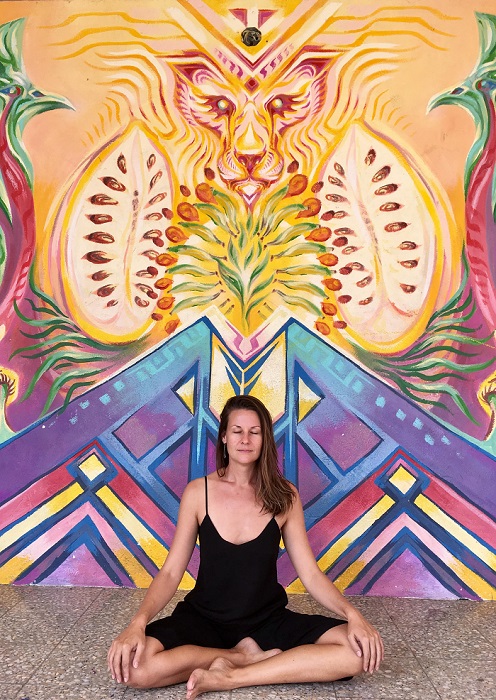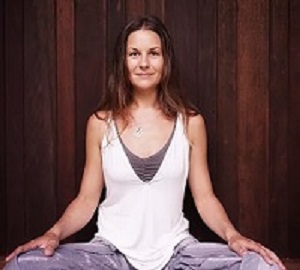When I first found yoga in my early twenties, the practice was all about the postures and physical form. The quiet moments before and after the physical stuff were nice, but they were short, and pretty much always filled with mental chatter and wondering what was going to happen next, a constant stream of thoughts, anxieties, judgements and plans. In fact, I did not even realize that it was possible for my mind to be without the chatter and storyline. I would sporadically write in a journal and had experienced moments of release and relief through writing, but the idea of a writing practice was not on my radar.

During my first 200 hour Yoga Teacher Training we delved into meditation practice and self study, and my inner world came rushing at me terrifyingly. I had probably never actually sat with myself and listened in my entire life. Cue emotional break down and patterns of avoidance, deeper focus and attachment to an ego driven physical practice and whatever makes me feel like I’m in control.
My ego said: How about I just skip the hard part, circumvent the 5,000 year old system of yoga and just get really good at handstands. That will make me a better person, and who cares anyways, I passed my 200hr so I’m enlightened and wise. Sitting still is hard and I don’t like what I hear when I listen in on my thoughts. Besides, who will like a photo of me just sitting on the floor in my pyjamas with my eyes closed? Nothing is HAPPENING. It’s completely unglamorous and uninteresting.
In a world obsessed with events, ideas, images, actions and productivity, it’s hard to imagine that simply sitting and being still and present could possibly be a good thing. We judge people who just sit around as lazy and unsuccessful. In Western culture we are taught this from day one.
We don’t learn the importance of BEING, we focus on DOING and productivity. Which is probably why starting a practice of meditation and self study can feel so daunting, even for the experienced yoga asana practitioner. Even though the physical postures are meant to be practiced so that we are able to sit in meditation.
So what exactly are the benefits of creating a meditation and personal writing practice? Note that PRACTICE means with regularity, consistency and for an extended period of time, ideally we want to do this daily in order for it to be most effective.
Increased focus, creativity and mental clarity
Relief from stress, anxiety and depression*
Creates perspective, the little things that bother us feel less heavy
Greater connection to your inner world and highest Self
Clarity of goals and personal direction
Management and release of strong emotions
Improved personal relationships, greater compassion and empathy
*Causes of depression and anxiety vary, and sometimes are a result of a chemical imbalance within the brain, in such cases meditation can help but is in no way a replacement for treatment prescribed by a doctor.
To see if you may have depression, you can also take a depression test.
Sounds great right? But, what exactly is meditation and how do we do it?
Well, there are many activities that can feel meditative, basically anything that has us in our current experience, or “in flow”. Yoga asana, rock climbing, paddling, surfing, skiing, walking, running, cooking, painting, writing, etc. Can all feel meditative and have great benefits. However, all of these activities require action, we must DO them.
Meditation is the absence of action, it is simply being present, in a moment when there’s nothing to be done. Sitting in stillness and simply breathing, listening, and observing what IS in each changing moment.
There are many guided meditations you could listen to, or techniques to explore if you feel like you need more structure or guidance to follow, but remember that what it’s really about is just BEING. You don’t need to always give yourself something to DO.
So where to we start, and how do we keep going even when it feels challenging?
Page Contents
When beginning any new project or endeavour, having a plan is helpful before we dive right in, and it gives us guidelines to follow. First, decide what time of day you can carve out some time for yourself. Ideally first thing in the morning, or before bed in the evening. Second, choose or create a space where you will actually do this practice, maybe a comfy space in your bedroom, living room or if possible an outdoor space. Put some love into the space, make it tidy and comfortable, make it somewhere you want to spend time everyday. This could be as simple as sweeping the floor and placing a mat and cushion down so that it’s ready for you when you wake up in the morning.
Start with a small chunk of time, 5-10 minutes at first, then gradually increase to 20-25 minutes, eventually working up to 30 minutes or longer. Choose your length of time and set a timer for it. Know that your timing might vary day to day depending on your schedule. 5 minutes is better than no minutes!
If you’re doing your practice in the morning, ideally it would be one of the first things you do upon waking. Do not look at your phone first. Try not to get into any emails, texts or social media before meditating. Trust me, this will make the practice much easier as these things tend to set our minds off to the races. I sleep with my phone on airplane mode, and do not switch it back on until after my meditation and writing practice is done. If evening is a better time for you, make your meditation the last thing you do before bed. Give yourself some space between screen time and meditation time. Shut down the electronics and get yourself comfy and ready for bed, take a shower or bath or whatever your nightly routine is before you sit down to meditate.
It’s pretty challenging to focus your awareness on the present moment when there is something physically uncomfortable nagging us – a sore knee, stiff back, itchiness, etc etc. Which is one of the reasons why the physical practice often comes first, to open the body so it can be comfortable sitting for an extended period of time. However, truth be told, you do not have to be accomplished or in practice of physical yoga postures to gain all the benefits of meditation. You do not have to be able to sit in a perfect lotus posture with your legs crossed, you can sit in whatever position is most comfortable for you. I highly recommend a cushion or prop to elevate yourself if you’re sitting on the floor, you could even have your back against a wall or be in a chair if its just too uncomfortable to be on the floor unsupported. Try some different things and figure out what works for you, knowing that this can change and vary day to day.

Writing and meditation do not necessarily have to go hand in hand. Maybe you’ll start with one or the other and see where it takes you. However, immediately before or after meditation is an excellent time to do some writing. Perhaps not the kind of writing that feels productive or particularly creative, but the kind of writing that feels like it is just pouring out of you, slowing down and releasing the chatter from the mind. Often referred to as “stream of consciousness writing”. Unedited, unfiltered, simply taking thoughts, emotions and ideas out of your brain and putting them on paper, with a pen. Writing that is not intended to be read by anyone else, never to be critiqued or reviewed, simply writing for the sake of processing. You could give this some structure by allotting a length of time (15-30mins or whatever you have time for) or by allotting a number of pages to write (2-4 journal pages).
Both meditation and writing can bring up a lot of stuff that we maybe didn’t even know was there, it can resurface the things we have buried deep within us, which can feel scary or sad. Try your best to stay present and curious about what comes up, try not to judge or “fix” the things that come up that you may perceive as negative, and try not to cling to things that you perceive as positive. Simply watch it all unfold and see what happens within your ever changing current experience.
Lastly, be gentle with yourself, enter the practice without expectation or the desire to be good at it. Some days will feel easy and blissful within your meditation and writing, other days will feel uncomfortable and hard. Know that as an ever changing human BEING there is no right or wrong, there just IS.
